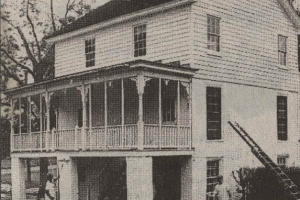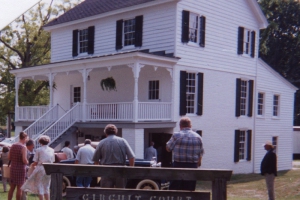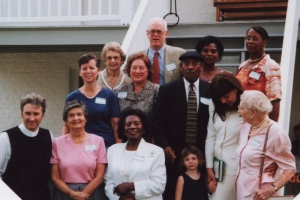As reported in a Virginia newspaper, “The King and Queen Courthouse Tavern Museum is a Real Gem…located in a Middle Peninsula county with a lot of rural charm.” The out-of-the-way location easily evokes the past that the Museum is preserving.
Museum Attractions
This website provides a glimpse of the many attractions offered by the Tavern Museum and the Courthouse Green Historic District: the historic Tavern building, the nine permanent exhibits, the one changing exhibit, and the other historic buildings in the immediate vicinity of the Tavern Museum. For the Researcher and Genealogist this website describes the resources available at the Museum: the library, the archives, the DVDs and the Historical Society Bulletins.
The Tavern Museum’s Beginnings
In the late 1990s, King and Queen County built a new Administration Complex at King and Queen Court House, Virginia. One of the county’s older buildings, the Fary Tavern, would no longer be needed. The King and Queen Historical Society saw this as an opportunity to found a museum to promote and display many of the artifacts and communicate the history of the county that it had been collecting for close to 45 years.
The Historical Society formed a committee to determine the feasibility, prepare a plan and make it happen. The challenges were very large, but not insurmountable: seeking the cooperation of the county and state, raising almost $300,000 to rehabilitate a 200 year building in need of repair, adhering to historic architectural guidelines in its reconstruction, staying within a very strict budget, relying on the public for furnishings, creating informative exhibits, and establishing a volunteer administration support team. This might have been overpowering for the average team, but not for the Historical Society’s all-volunteer team.
This group met the challenges first by working with the county and state to have the old Court House complex, including the Fary Tavern, designated a Virginia Landmarks Historic District in 1998. With this designation and a lease agreement with the County, funds could be solicited from the state for renovation if matching funds could be obtained from the private sector. The state approved funding of $150,000 and the Jesse Ball duPont Fund provided a grant for the matching private funds and construction began. “An outstanding private and public partnership.” Once construction was underway the Historical Society developed plans for exhibits and video tour, and raised over $100,000 for this purpose from private citizens. The Historical Society solicited furnishings and artifacts for the museum from private citizens for donation or loan through their own King and Queen style “Antiques Road Show.”
December 9, 1999 was ground breaking for the renovation of the Fary Tavern. In 2000 a preview of the work was part of the program at the Historical Society Meeting in August. The Museum officially opened to the public in May 2001, an outstanding achievement for the Historical Society of an economically challenged rural county.
Partnership With the County
Today the King and Queen Historical Society operates the Courthouse Tavern Museum in cooperative partnership with King and Queen County, Virginia, to bring the Museum’s services to the general public. The Museum building is owned by the County and leased to the Historical Society. The County pays for all utilities, insurance, maintenance, and similar expenses. The collections and endowment are owned by the Historical Society. The Historical Society provides volunteers to open the museum and is responsible for exhibits, education, acquisitions, endowment and related activities. The Museum is funded by the Historical Society, admission fees, sales of items such as books and DVDs, and private donations. At times grants are obtained for special purposes.
Mission Statement
The Museum’s mission is to be an archive, museum and cultural center for King and Queen County history, principally as (1) a library for papers and books related to King and Queen County and its citizens, (2) a repository for artifacts, (3) a showcase for period tavern/hotel living, (4) a place to inform the public of various aspects of life in the county over its history and (5) an office for the Historical Society. It is to benefit the children and adult residents of the County, as well as visitors to the County. As a cultural center the building is available for public and private meetings, as a learning center for schools, and for training opportunities in the museum field.



